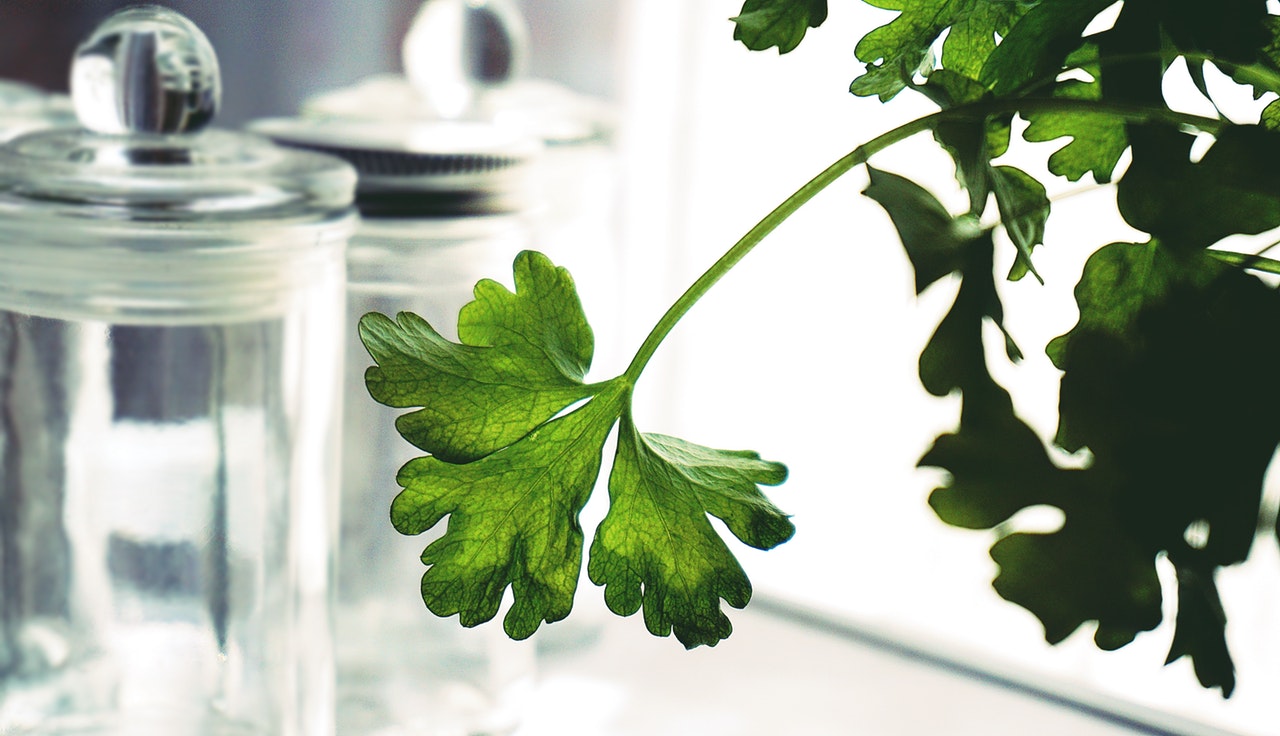Food is medicine to a herbalist.
During this time incorporating antiviral foods in our diet can help improve our overall health. Many foods in our kitchen and in our garden already offer powerful defense against viruses. We can reinforce them with the power of our intention and use them in a mindful way. Basil, Garlic, Oregano, Pesto, Thyme, Rosemary and Turmeric are all foods that have antiviral properties to them. There are some foods that are specifically related to supporting our lungs. Carotene rich foods, Orange, Yellow, Red, Dark Green colored foods are all welcome addition to our dinner tables, as well as green leafy vegetables. A recent study shows some of these foods to specifically protect against lung cancers, hence being strengthening the immune system and our lungs.
Increase Vitamin-rich Foods & Decrease Sugar
Our immune system can be optimized by adequate intakes of Vitamin D, Vitamin C, Zinc and Probiotics. The best form of these is usually food. Nature is the best supplement manufacturer, and our bodies have a special affinity for supplements packaged by nature in its fruits and vegetables. And just like this is an excellent time to add healthy foods to our diet, this is an excellent time to decrease and try to eliminate foods that have a high glycemic index and a lot of sugar. “Fake foods” can affect our immune system and make us more vulnerable to infections and poor health.
Power Herbs
I have mentioned a few herbs here. The list is long but some of the herbs mentioned here can be combined in a formula based for an individual’s particular needs. A note of caution: Before using for yourself or your loved ones, please consult a knowledgeable herbalist. Every individual benefits from a unique and specific combination of herbs. And just because these herbs are produced by Mother Nature does not mean they are free of side effects.
Mushrooms[i] like Red Reishi, Black Reishi, Shiitake, Maitake, Cordyceps and Chaga are nature’s answer to “balancing” the immune system. They dampen an immune system that is hyperactive and strengthen an immune system that is not active enough. That is why they can be great additions to formulas for allergies, tumors and infections. They are also excellent anti-inflammatories and can help support the liver while it is trying to detoxify.
Andrographis Aerial Parts[ii] is a bitter herb native to Asia which stimulates the immune system, decreases fever and is a potent antibacterial, antifungal and antiviral. It also is excellent as a bitter, helping us absorb the nutrients of our food better by priming our gut.
Isatis root[iii] is a strong antiviral that some people have used with success in eruptive viral diseases like chickenpox. It was one of the herbs that actually was effective against SARS. Herbalists like to say that it cools the blood since a lot of eruptions are seen as heat in the blood.
Lomatium root[iv] is a strong antiviral that also loosens up phlegm in the lungs. It is an herb that natives of Pacific northwest have used since time immemorial and was introduced to the western medical practice during the Great Influenza pandemic of 1918-1919. The Indians called the medicinal root of this plant, “Dortza” which meant, “heap powerful medicine”.
Astragalus root[v] is another immune system “balancer”. It shines especially in lung conditions associated with decrease vitality.
Platycodon root[vi] is an expectorant and calms coughs and is a lung remedy that is anti-inflammatory and can also be useful for decreasing fevers.
Osha root[vii] is a plant that bears emerging from hibernation love to chew, spit on their paws and then rub all over themselves. It has volatile compounds that not only help detoxify but also act as antiviral and antibacterial. It also helps loosen mucous making coughing easier.
Baical Scullcap[viii] (not to be confused with Scuttelaria Lateriflora) is another antibacterial and antiviral. It is used for conditions that cause heat in the body, like various infections.
Licorice root[ix] is an excellent adaptogen which our body needs during periods of stress. It is soothing to the lungs and relieves irritation. This is one of nature’s pharmacy plant with multiple properties. It befriends other herbs and influences them, thus enhancing or dampening certain effects of each herb. It is thus used as a “harmonizer” in small quantities in various herbal formulas.
Khella seed[x] relieves spasms, not only of the bronchi, but also of the intestines, gall bladder and genitourinary tract.
Cinnamon bark[xi] is an excellent stimulant to our circulatory system besides having antiviral and antibacterial agent. It decreases insulin resistance and can also help dry out lung secretions.
Lobelia seed and fresh flowering herb[xii] are usually used in very small quantities. This is an herb that can make you regret indulgence. Overdo it and it does not spare you terrible nausea. It is however great for lung spasms, dilating brochi, antibacterial actions and having mild sedative properties.
If you have questions about using herbs, please contact us to schedule a consultation.
Digging Deeper in the Research
While this article is not intended as medical advice, it is important to recognize that there are many scientific studies which have been done on these herbs, some of which are cited below:
[i] Hijikata, Y., Yamada, S., Effect of Ganoderma lucidum on Postherpetic Neuralgia, Am J Chin Med, 1998;26(3-4):375-81
Kelly-Pieper, K., Patil, S.P., et al, Safety and Tolerability of an Antiasthma Herbal Formula (ASHMI) in Adult Subjects With Asthma: A Randomized, Double-Blinded, Placebo-Controlled, Dose-Escalation Phase 1 Study, J Altern Complement Med, 2009;15(7):735-43
Wachtel-Galor, S., Yuen, J., et al, Ganoderma lucidum (Lingzhi or Reishi), A Medicinal Mushroom in Herbal Medicine: Biomolecular and Clinical Aspects, 2nd ed., CRC Press, 2011, Boca Raton, FL
Xu, J., Huang, Y., et al, The Mechanisms of Pharmacological Activities of Ophiocordyceps sinensis Fungi, Phytother Res, 2016 Oct;30(1):1572-83
Liu, Y., Wang, J., et al, The Chemical Constituents and Pharmacological Actions of Cordyceps sinensis, Evid-Based Complement Alter Med, 2015;575063:12 pp
Ma, L., Chen, H., et al, Anti-Inflammatory and Anticancer Activities of Extracts and Compounds From the Mushroom Inonotus obliquus, Food Chem, 2013 Aug 15;139(1-4):503-8
Kodama, N., Komuta, K., et al, Effect of Maitake (Grifola frondosa) D-Fraction on the Activation of NK Cells in Cancer Patients, J Med Food, 2003 Winter;6(4):371-7
Vetvicka, V., Vetvickova, J., et a., Immune=Enhancing Effects of Maitake (Grifola frondosa) and Shiitake (Lentinulaedodes) Extracts, Ann Transl Med, 2014;2(2):14
Wesa, K.M., Cunningham-Rundles, S., et al, Maitake Mushroom Extract in Myelodysplastic Syndrome (MDS): A Phase II Study, Cancer Immunol Immunother, 2015 Feb;64(2):237-47
[ii] Coon, J.T., Ernst, E., Andrographis paniculata in the Treatment of Upper Respiratory Tract Infections: A Systematic Review of Safety and Efficacy, Planta Med, 2004 Apr;70(4):293-8Gabrielian, E.S, Shukarian, A.K., A Double Blind, Placebo-Controlled Study of Andrographis paniculata Fixed Combination Kan Jang in the Treatment of Acute Upper Respiratory Tract Infections Including Sinusitis, Phytomedicine 2002 Oct.; 9 (7):589-97
Wintachai, P., Kaur, P., et a, Activity of Andrographolide Against Chikungunya Virus Infection, Sci Rep, 2015 Sep 18;5:14179
[iii] Gou, H., Mao, J., et al, Varicella-Zoster Virus Prophylaxis With the Traditional Chinese Medicine Radix Isatidis (Banlangen) in Patients With Multiple Myeloma Treated With Bortezomib, J Alt Complemen Med, 2011;17(11):985-6
Ho, Y.L., Chang, Y.S., Studies on the Antinociceptive, Anti-Inflammatory and Anti-Pyretic Effects of Isatis indigotica Root, Phytomedicine, 2002 Jul;9(5):419-24
Yang, Z., Wang, Y., et al, In Vitro Inhibition of Influenza Virus Infection by a Crude Extract From Isatis indigotica Root Resulting in the Prevention of Viral Attachment, Mol Med Report, 2012 Mar;5(3):793-9
Yang, Z.C., Wang, B.C., et al, The Synergistic Activity of Antibiotics Combined with Eight Traditional Chinese Medicines Against Two Different Strains of Staphylococcus aureus, Colloids Surf B Biointeraces, 2005 Mar 25;41(2-3):79-81
[iv] Caldecott, T., Western Materia Medica-Lomatium dissectum, http://www.toddcaldecott.com/pdf%20files/publication/ western%20herbs/biscuit%20root.pdf McCutcheon, A.R., Roberts, T.E., et al, Antiviral Screening of British Columbian Medicinal Plants, J Ethnopharmacol, 1995 Dec 1;49(2):101-10
[v] Brush, J., Mendenhall, E., et al, The Effect of Echinacea purpurea, Astragalus membranaceus, and Glycyrrhiza glabra on CD69 Expression and Immune Cell Activation in Humans, Phytother Res, 2006, Aug;20(8):687-95
Chen, S.M., Tsai, Y.S., et al, Astragalus membranaceus Modulates Th1/2 Immune Balance and Activates PPARy in a Murine Asthma Model, Biochem Cell Biol, 2014 Oct;92(5):397-405
Cho, W.C., Leung, K.N., In Vitro and In Vivo Immunomodulating and Immunorestorative Effects of Astragalus membranaceus, J Ethnopharmacol, 2007;113(1):132-41
Mao, S.P., Cheng, K.L., et al, Modulatory Effect of Astragalus membranaceus on Th1/Th2 Cytokine in Patients With Herpes Simples Keratitis [Article in Chinese], Zhongguo Zhong Xi Yi Jie He Za Zhi, 2004;24(2):121-3
Zou, C., Su, G., et al, Astragalus in the Prevention of Upper Respiratory Tract Infection in Children With Nephrotic Syndrome: Evidence-Based Clinical Practice, Evid Based Complement Alternat Med, 2013;2013:352130. doi: 10.1155/2013/352130
Xiaoxia, L., Lu, Q., et al, A Review of Recent Research Progress on the Astragalus Genus, Molecules, 2014;19:18850-90
[vi] Zhang, L., Wang, Y., et al, Platycodon grandiflorus-An Ethnopharmacological, Phytochemical and Pharmacological Review, J Ethnopharmacol, 2015 Apr 22;164:147-61
Lee, K.J., Kim, J.Y., et al, Inhibition of Tumor Invasion and Metastasis by Aqueous Extract of the Radix of Platycodon grandiflorum, Food Chem Toxicol, 2006, Nov;44(11):1890-6
[vii] Ciegiela-Carlioz, P., Bessiere, J-M., et al, Modulation of Multi-Drug Resistance (MDR) in Staphylococcus aureus by Osha (Ligusticum porteri L., Apiaceae) Essential Oil Compounds, Flav Frag J, 2005;20:6:671-5
León, A., Toscano, R.A., et al, Phthalides and Other Constituents From Ligusticum porteri; Sedative and Spasmolytic Activities of Some Natural Products and Derivatives, Nat Prod Res, 2011 Aug/25(13):1234-42
Linanes, E., & Bye, R., A Study of Four Medicinal Plant Complexes of Mexico and Adjacent United States, Jrl. Ethnopharmacology, 1987;19(2):153-83
[viii] Chen, J.J., Huang, C.C., et al, Scutellaria baicalensis Ameliorates Acute Lung Injury by Suppressing Inflammation In Vitro and In Vivo, Am J Chin Med, 2017;45(1):137-57
Jung, H-S, Kim, M-H, Gwak, et al, Antiallergic Effects of Scutellaria baicalensis on Inflammation In Vivo and In Vitro, J Ethnopharmacol, 2012;141:345-9
Smol’ianinov, E.S., Gol’dberg, V.E., et al, Effect of Scutellaria baicalensis Extract on the Immunologic Status of Patients With Lung Cancer Receiving Antineoplastic Chemotherapy [Article in Russian], Eksp Klin Farmakol, 1997;60(6):49-51
[ix] Wang, L., Yang, R., et al, The Antiviral and Antimicrobial Activities of Licorice, a Widely-Used Chinese Herb, Acta Pharmaceutica Sinica B, 2015;5(4):310-5
Beresford, T., Glycyrrhiza glabra and Treatment of Respiratory Disorders, 2002, www.ann.com.au/features/glycyrrhiza_glabra.htm
Nassiri, M.N., Hosseinzadeh, H., Review of Pharmacological Effects of Glycyrrhiza sp. and its Bioactive Compounds, Phytotheraphy Research, 2008;2:709-24
[x] Weiss, R., MD, Herbal Medicine-Classic Edition, Theime, Stuttgart, 2001, pp. 221-2
Wichtl, M., Herbal Drugs and Phytopharmaceuticals, MedPharm, Stuttgart, 2004, pp. 34-7
[xi] Nabeshima, S., Kashiwagi, K., et al, A Randomized, Controlled Trial Comparing Traditional Herbal Medicine and Neuraminidase Inhibitors in the Treatment of Seasonal Influenza, J Infect Chemother, 2012 Aug;18(4):534-43
Mandal, S., DebMandal, M., et al, In Vitro Antibacterial Activity of Three Indian Spices Against Methicillin-ResistantStaphylococcus aureus, Oman Med J, 2011;26(5):319-23
H.-K. Kwon, W K Jeon, et al, Cinnamon Extract Suppresses Tumor Progression by Modulating Angiogenesis and the Effector Function of CD8+ T Cells, Cancer Lett, 2009, doi:10.1016/j.canlet.2009.01.015
[xii] Felpin, F-X., Lebreton, J., History, Chemistry and Biology of Alkaloids From Lobelia Inflata, Tetrahedron, 2004;60:10127 -53
Stansbury, J., Saunders, P.R., et al, The Use of Lobelia in the Treatment of Asthma and Respiratory Disease, J Resor Med, 2013;2:94-100






